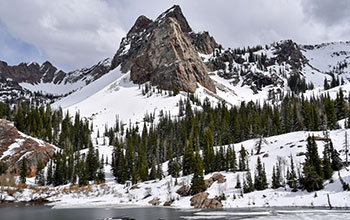Multimedia Gallery
Sundial Peak in the Wasatch Mountains
Sundial Peak (elevation 10,320 feet, or 3,146 meters) in the Wasatch Mountains with Lake Blanche (elevation 8920 feet, or 2718 meters) in the foreground, May 2016. A study by researchers at the University of Utah has found that spring snowpack, relied on by ski resorts and water managers throughout the Western U.S., may be more vulnerable to a warming climate in coming decades than first thought, according to a University of Utah study.
More about this image
The University of Utah study modeled the year-to-year variability in precipitation and temperature in Utah’s Wasatch Mountains and other ranges in the West. Jason Scalzitti, a graduate student in atmospheric sciences, and professors Court Strong and Adam Kochanski found that above a threshold elevation, the amount of spring snowpack is dependent more on the amount of precipitation in a year than the temperature. In other words, whether a year is wet matters more than if it’s warm. But below that threshold, temperature matters more. By the end of the century, according to the study, that threshold will move uphill by around 800 feet in the Wasatch and more in the Sierra Nevada, Cascades and parts of the Rocky Mountains.
"In the past we’ve thought mainly about total precipitation as an indicator of how good the ski seasons going to be," says Strong. "As we move into the future, especially at elevations below the threshold, temperature increases in importance."
In addition to impacting ski resorts--and thus, Utah's economy--another impact will be on water resources. Melting spring snowpack fills reservoirs, providing water for the residents of the Salt Lake Valley. Spring snowpack amounts are a key indicator for water managers of how much water they’ll have available in reservoirs for the coming year.
"They look at that as how much water is available in the form of snow to melt and capture in the reservoirs," Strong says. "That will be down in the future. Even if we have the same amount of water coming into the system, it will be melting earlier and faster. If we want to supply that to a growing population, then we need increased storage capacity."
This work was partially supported by iUTAH EPSCoR and funded by the National Science Foundation.
To learn more about this research, see University of Utah news story Spring snow a no-go?. (Date image taken: May 21, 2016; date originally posted to NSF Multimedia Gallery: Oct. 4, 2016)
Credit: David White
See other images like this on your iPhone or iPad download NSF Science Zone on the Apple App Store.
Special Restrictions: When using this image the owner, David White, has requested that you send him the link to wherever you use his material so that he can view it. His email is david.white@utah.edu.
Images and other media in the National Science Foundation Multimedia Gallery are available for use in print and electronic material by NSF employees, members of the media, university staff, teachers and the general public. All media in the gallery are intended for personal, educational and nonprofit/non-commercial use only.
Images credited to the National Science Foundation, a federal agency, are in the public domain. The images were created by employees of the United States Government as part of their official duties or prepared by contractors as "works for hire" for NSF. You may freely use NSF-credited images and, at your discretion, credit NSF with a "Courtesy: National Science Foundation" notation.
Additional information about general usage can be found in Conditions.
Also Available:
Download the high-resolution JPG version of the image. (12.0 MB)
Use your mouse to right-click (Mac users may need to Ctrl-click) the link above and choose the option that will save the file or target to your computer.



